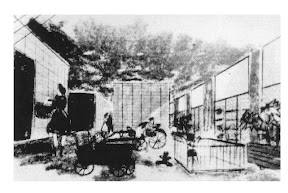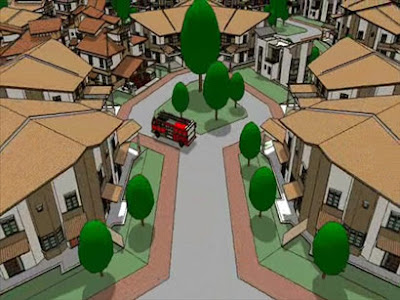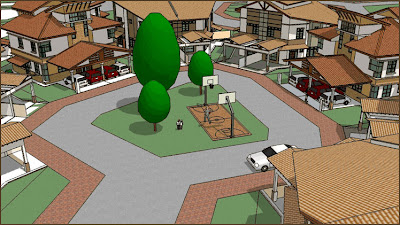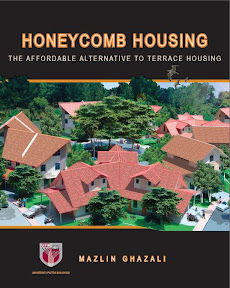Protection from Crime
One aspect is safety from crime, and the concept of “Defensible Space” which evolved some 40 years ago when American architect Oscar Newman was witness to what happened at the newly constructed, 3,000-unit, public housing high-rise development at Pruitt Igoe. This was an infamous public housing scheme that was eventually demolished.
However, across the street from Pruitt-Igoe was an older, smaller, row-house complex occupied by an identical population, Carr Square Village. It remained fully occupied and trouble-free throughout the construction, occupancy, and decline of Pruitt-Igoe. With the social variables constant in the two developments, what, Newman asked himself, was the significance of the physical differences that had enabled one to survive while the other fell apart?

Pruitt Igoe - architectural illustrations versus actual photos
Newman believed that that design should propagate “natural surveillance” generating opportunities for people to see and be seen continuously. Knowing that they are, or could be, watched makes residents feel less anxious, leads them to use an area more and deters criminals by making them fear being identified and caught.
Second, people must not only watch but also be willing to intervene or report crime when it occurs. Newman proposed reducing anonymity and increasing territorial feelings by dividing larger spaces into zones of influence. This can be accomplished on a small scale by clustering a few apartments around a common entrance or a common elevator. On a larger scale individual yards or areas can be demarcated by having paths and recreational areas focus around a small set of apartment units or by having each building entry serve only a limited number of apartments.
Newman considered man as a territorial being, as a being that needs territory like he needs water, in order to be able to live a satisfactory life. He posited that man is not basically criminal – preferring social cohesiveness to anarchy, social harmony to tension. Providing surveillance over defensible spaces allows man to be in his natural state, surveying and defending his domain.
Newman and his followers tested these ideas by studying housing developments in cities across the country, from New York to San Francisco, and concluded that rates of crime, vandalism and turnover were lower in places that conformed to the principles of defensible space. In a variety of large and small cities, housing projects and urban neighborhoods have been redesigned in accord with defensible space principles. While the results have not been consistent, reductions in crime and fear and increases in a sense of community have been found in several places. The concept of Defensible Space enabled residents to take back control of their neighbourhoods and reduce crime. (Charles Mercer).
As for the Pruitt Igoe project, it was demolished by controlled explosion. Minoru Yamasaki would later design the World Trade Center. This was one very unlucky architect.
Pritt Igoe demolished
Oscar Newman’s idea of “Defensible Space” has been augmented by the work of psychologists in the area of CPTED, Crime Prevention Through Environmental Design.
CPTED strategies rely upon the ability to influence offender decisions that precede criminal acts. Research into criminal behaviour shows that criminals are more influenced by cues to the perceived risk of being caught than by cues to reward or ease of entry. Consistent with this research, CPTED based strategies emphasize enhancing the perceived risk of detection and apprehension.
Consistent with the widespread implementation of defensible space guidelines in the 1970s, most implementations of CPTED as of 2004 are based solely upon the theory that the proper design and effective use of the built environment can reduce crime, reduce the fear of crime, and improve the quality of life. Built environment implementations of CPTED seek to dissuade offenders from committing crimes by manipulating the built environment in which those crimes proceed from or occur. The three most common built environment strategies are natural surveillance, natural access control and natural territorial reinforcement. Natural surveillance and access control strategies limit the opportunity for crime. Territorial reinforcement promotes social control through a variety of measures.
Natural surveillance
Natural surveillance increases the threat of apprehension by taking steps to increase the perception that people can be seen. Natural surveillance occurs by designing the placement of physical features, activities and people in such a way as to maximize visibility and foster positive social interaction among legitimate users of private and public space. Potential offenders feel increased scrutiny and limitations on their escape routes. (Cite Wikipedia CPTED 7th May 2007)
looping road and the central green area are focal points with plentiful ‘eyes on the street’.
- Windows are also placed overlooking the short stretches of connecting roads and footpaths and points of entry.
- Use the shortest, least sight-limiting fencing
- Natural surveillance measures can be complemented by organizational measures like, for example, closed-circuit television (CCTV) cameras.
From inside this house the residents can see the activities outside. In fact the courtyard becomes the focus of the neighbourhood, because all houses in the courtyard are facing it.
Natural access control
Natural access control limits the opportunity for crime by taking steps to clearly differentiate between public space and the localised neighbourhood.
The honeycomb cul-de-sac would typically have one vehicular entrance route and perhaps one or two footpaths. Placing clearly identifiable design cues at these entrances will further limit access or control flow, and improve natural access control.

Into the courtyard above is only one entrance with many windows placed to overlook it.
Natural territorial reinforcement
Territorial reinforcement promotes social control through increased definition of space and improved proprietary concern. An environment designed to clearly delineate private space does two things. First, it creates a sense of ownership. Owners have a vested interest and are more likely to challenge intruders or report them to the police. Second, the sense of owned space creates an environment where "strangers" or "intruders" stand out and are more easily identified.
Territorial reinforcement measures make the normal user feel safe and make the potential offender aware of a substantial risk of apprehension or scrutiny.

In this courtyard, the residents are invited by shared landscaping and sports facilities to claim as their own.
Maintenance
It also encourages the residents to maintain the common space, and this is also an important element in the expression of ownership of that common space. Deterioration indicates less control by the intended users of a site and indicate a greater tolerance of disorder. The 'Broken Windows Theory' is a valuable tool in understanding the importance of maintenance in deterring crime. Broken Windows theory proponents support a zero tolerance approach to property maintenance, observing that the presence of a broken window will entice vandals to break more windows in the vicinity. The sooner broken windows are fixed, the less likely it is that such vandalism will occur in the future.


No comments:
Post a Comment